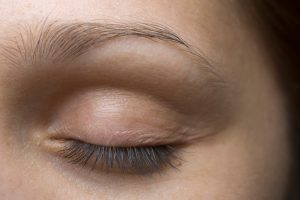
In its early stage, Meibomian gland disorder does not cause any symptoms, but if left untreated, it can result in dry eyes and eyelid inflammation. Chronic clogging of the oil glands can lead to permanent changes in the tear film.
Meibomian gland dysfunction (MGD) causes and risk factors
MGD develops when the Meibomian glands do not produce enough oil or when that oil is of poor quality. The oil produced by these glands is necessary to protect the eye and maintain healthy tear film.
Lack of oil or its poor quality is associated with evaporative stress, a result of infrequent blinking, which makes the oil thicker and this way clogs the glands.
Risk factors for MGD include being of older age, being of Asian descent, wearing eye makeup like eyeliner or mascara, and wearing contact lenses.
MGD signs and symptoms
Diagnosis and tests for MGD
You will need to see a doctor if you begin to experience symptoms related to MGD. Your doctor will apply pressure to the eyelid and observe the secretions from the oil glands. By completing this simple test, your doctor will be able to confirm MGD diagnosis.
A useful diagnostic tool was developed by a company known as TearScience. The device standardizes the amount of force used for expressing the oil glands. The tool helps doctors confirm the diagnosis and assess the severity of the disorder.
Another test is known as the tear breakup time (TBUT). In this painless procedure, a small amount of dye is applied to the tear film on the eye’s front surface. The doctor then observes how quickly – or slowly – the tear film loses its stability.
Meibomian gland dysfunction treatment
Typical treatment for MGD involves applying a warm compress to the affected eye and massaging the eyelids to help melt and release trapped oil in the glands. Although these methods are somewhat effective, there are newer treatments that have increased success of treating MGD. These include:
- Meibomian gland probing: The eye doctor unclogs the gland and applies eye drops using a handheld device to probe the opening of the gland
- Antibacterial eye drops
- Cyclosporine eye drops
- LipiFlow: Designed by TearScience, this is a thermal pulsation system that applies heat to the eyelids to melt away the waxy oil buildup and applies pulsed pressure to excrete more oil from the glands. This treatment is administered in the doctor’s office.
Speak to your doctor about treatment options available for your case of MGD.